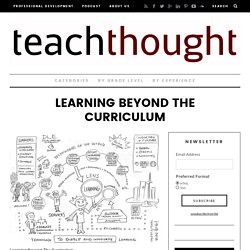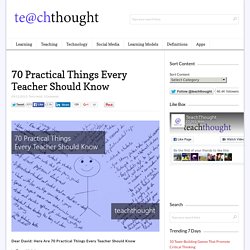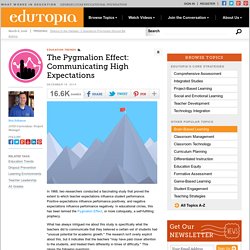

5 Principles of Outstanding Classroom Management. 1.

Take Care of Yourself to Take Care of Your Students As the airline safety videos say: Put on your own oxygen mask first. To learn effectively, your students need a healthy you, said our experienced teachers. So get enough sleep, eat healthy food, and take steps to attend to your own well-being. In her first year of teaching, Jessica Sachs “was working 15-hour days and was completely stressed out. Countless studies corroborate the idea that self-care reduces stress, which can deplete your energy and impair your judgment. 6 Scaffolding Strategies to Use With Your Students.
What’s the opposite of scaffolding a lesson? Saying to students, “Read this nine-page science article, write a detailed essay on the topic it explores, and turn it in by Wednesday.” Yikes! Returning to learning – Rubik’s Cube revenge. On Thursday, 30 March 2017 at 9.21pm AEDT I successfully solved a Rubik’s Cube for the first time.

We ask students to do it every day, but when was the last time you ventured out of your comfort zone to learn something new? I don’t mean ‘self-learning’ via a YouTube video, flicking through a book or an instruction manual, or surfing the internet. Rather, learning a new skill with the aid of a teacher in the same room. As an educator, it’s interesting to reflect on how you feel when you put yourself in that position; the highs and lows that boost and hamper your progress, the help and scaffolding you received along the way. 8 Characteristics Of A Great Teacher. 8 Characteristics Of A Great Teacher by Ian Lancaster What makes a teacher strong?

What differentiates the best from the rest? There’s no shortage of bodies (some dramatically misguided) attempting to solve this riddle. The answers are nebulous at best. 1. Confidence while teaching can mean any number of things, it can range from having confidence in your knowledge of the material being learned to having confidence that your teaching acumen is second to none. Why Do High School History Teachers Lecture So Much? Why Do High School History Teachers Lecture So Much?

By Grant Wiggins, Authentic Education. Learning Beyond The Curriculum. Learning Beyond The Curriculum by Stewart Hase and Chris Kenyon Ed note: This is part 2 in a series on self-determined learning from Stewart Hase and Chris Kenyon.

Stewart’s site, Heutagogy Community of Practice, is a useful resource for reading on Self-Determined Learning. The first post was Shifting From Pedagogy to Heutagogy In Education. The science of learning, discovering how people learn, as opposed to the philosophy of learning and education that goes back to Egyptian times, can be sheeted back to around the tenth-century. 70 Practical Things Every Teacher Should Know. Dear David: Here Are 70 Practical Things Every Teacher Should Know.

The Basics Of Reflective Teaching: A Slo-Blog Approach. The Basics Of Reflective Teaching: A Slo-Blog Approach by Beth Leidolf As the school year kicks off, many classes, teachers and students begin with the basics, those building blocks that provide a firm foundation upon which more valuable learning and growing will take place.

With that in mind, the #reflectiveteacher community gets back to basics in this slo-blogging activity called built around the ABCs of being a #reflectiveteacher. Previously, our #reflectiveteacher challenge was a daily prompt. (You can find one example here.) 8 Questions Around The Basics Of Reflective Teaching. Edutopia. In 1968, two researchers conducted a fascinating study that proved the extent to which teacher expectations influence student performance.

Positive expectations influence performance positively, and negative expectations influence performance negatively. In educational circles, this has been termed the Pygmalion Effect, or more colloquially, a self-fulfilling prophecy. What has always intrigued me about this study is specifically what the teachers did to communicate that they believed a certain set of students had "unusual potential for academic growth. " Are You A Whole Teacher? A Self-Assessment To Understand -
Are You A Whole Teacher?

A Self-Assessment To Understand by TeachThought Staff Whole Child Learning is a thing; Whole Teaching should be a thing too, no? Here at TeachThought, Jackie Gerstein’s usergeneratededucation is at the top of our reading list, in large part for her thinking about the human side of formal education. Much of our content–that is, the content here at TeachThought, and that on her site–overlaps because of our shared perspective on teaching and learning: self-directed learning, the role of play in learning, the idea of citizenship, student-centered learning (and student-centered teaching), and more.
Essential teaching practices – do they exist? [Image © Shutterstock/StockLite] It is often observed that there is no single best way to teach – that what works for some learners under some conditions does not work for all learners under all conditions.

For this reason, it is argued, teachers require a broad repertoire of teaching methods that they can call on as appropriate. 27 Tips For Effective Classroom Management. Getting students to pay attention, let alone actually learn something, is a challenge. It takes grit, determination, creativity, and a close eye. Teachers, in-classroom parents, assistants, and administrators need to be as up to speed as possible in order to be effective.
When it comes to effective classroom management, there are a couple dozen things you should know. A wonderful visual created by Mia MacMeekin has me contemplating and thinking a bit differently about what it takes to effectively manage a classroom. Creating Successful Collaborations. For the past five years I have collaborated with a playwright who works with my students as they write original plays. The Difference Between Contemporary And Traditional Learning. The Quick Guide To Bilingualism In The U.S. New Padagogy Wheel Helps You Integrate Technology Using SAMR Model. Sometimes a visual guide comes along and it just makes total sense. That’s how I felt about Allan Carrington’s clever ‘Padagogy Wheel‘ which we featured on Edudemic last week. Check out the previous version then view the one below to see the differences.
From what I can tell, putting the wheel on this site has generated a bit of buzz and I’m glad we could help spread the knowledge. But I was quite amazed this morning when I saw that the Padagogy Wheel had been updated. Now at version 2.0, it features another band around the edge focusing on the SAMR Model and on helping teachers (and admins) effectively integrate education technology.
This new Padagogy Wheel (which honestly is less about iPads and more about technology integration now) should encourage you to focus on redefining your current standards, the current role tech plays in your classroom, and just about everything else. A Visual Guide To Every Single Learning Theory. The 27 Things Teachers Do Best. The 27 Characteristics Of Highly Effective Teachers.